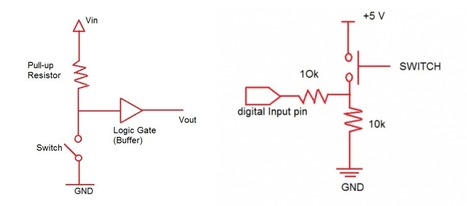If you check out any digital electronic circuit, you’ll mostly find pull-up and pull-down resistors in them. They are used to correctly bias the inputs of digital gates to stop them from floating around randomly when there is no input condition. For any microcontroller in an embedded system such as Arduino, pull-up and pull-down resistors utilize input and output signals for communication with external hardware devices, the General Purpose Input Output (GPIO). Implementing the pull-up and pull-down resistors in the circuit will let you achieve either ‘high’ or ‘low’ states. If you don’t implement it and there’s nothing connected to your GPIO pins, your program will read a “floating” impedance state.
Get Started for FREE
Sign up with Facebook Sign up with X
I don't have a Facebook or a X account


 Your new post is loading... Your new post is loading...
 Your new post is loading... Your new post is loading...
Secuencia didáctica cos materiais de tecnoloxía para 2º de ESO. Na aula virtual pódese descargar copia de seguridade para restaurar no Moodle do centro.
From
www
Porterillo/Telefonillo IA: Vamos a hacer un sencillo proyecto con micro:bit y la cámara Husky Lens programando con bloques Makecode
From
www
LoRa plataforma IoT de largo alcance es un video cortesía de PCBWay https://www.pcbway.com fabricante de circuitos impresos de alta calidad y bajo costo.
From
www
La programación puede parecer un reto intimidante para muchos principiantes.
¡Aquí vas a poder ver todos los exámenes de las Pruebas de Acceso Universitario de la materia de Tecnología e Ingeniería II de todas las Comunidades Autónomas en el curso 2024-25!
Blog recursos educativos. Tecnología ESO. Tecnología Industrial Bachillerato. Proyectos escolares tecnología. Tecnología secundaria. 1 2 3 4 ESO.
From
www
Es conocido que todo Condensador Electrolítico al conectarlo a un voltaje AC explotará, en este video te enseñare como Conectar cualquier Condensador Electrolítico a un voltaje AC de 220V o 110V AC sin que se dañe y forme parte de un circuito funcional.
From
blog
When 3D printing matured from an industrial edge case to a mainstream commercial technology in the 2010s, it captured the imaginations of everyone from schoolteachers to fashion designers. But if there’s one group that really, really got excited about 3D printing, it was makers.
From
canaltic
La Inteligencia Artificial nos puede ayudar a aprender. En este artículo se propone utilizar ChatGPT para crear un juego como el popular Akinator donde la IA trata de averiguar el personaje misterioso mediante preguntas Sí/No. Se crea un nuevo chat donde se sube un documento PDF con información sobre mujeres científicas canarias que hemos recopilado de Internet. ChatGPT tendrá en cuenta la información proporcionada en este archivo. De esta manera las preguntas y respuestas son más personalizadas y fiables.
From
www
Te damos algunas ideas para ahorrarte mucho tiempo en el trabajo o al hacer algunas tareas utilizando la inteligencia artificial.
The Raspberry Pi Pico 2 is the successor to the original Raspberry Pi Pico 1. Learn how to get started with Pico 2 and Pico 2 using MicroPython and Arduino IDE.
From
www
DietPi, la distribución de Linux que cuenta con algunas características y especificaciones que la hacen perfecta para la Raspberry Pi.
Vamos a tratar de resolver este crucigrama sobre estructuras para repasar los saberes vistos en clase. Aquí tienes el enlace para descargar el crucigrama: CRUCIGRAMA SOBRE ESTRUCTURAS También puedes tratar de resolver on line haciendo click en el enlace de abajo: CRUCIGRAMA INTERACTIVO |
From
www
En este video te enseñamos cómo usar una protoboard… ¡de una forma que no vas a olvidar! Acompañá a nuestros valientes LEDs animados mientras aprenden (o mueren intentando) a sobrevivir a los errores más comunes al conectar un circuito en una breadboard.
From
www
Circuito integrado 4093 CMOS NAND
From
wwwhatsnew
Aprender a programar y comprender los conceptos fundamentales de la inteligencia artificial ya no es un privilegio reservado para expertos o instituciones educativas. Con la llegada del CrowPi 3, estamos ante una herramienta pensada para quienes quieren explorar el mundo de la tecnología sin perderse entre cables, soldaduras o manuales interminables. Y lo mejor: no importa si tienes 10 años, 30 o 70.
From
www
Dibujo de polígonos en Scratch. Sirve para practicar los bucles y conocer los datos de polígonos, dentro del currículo a partir de tercer ciclo de primaria.
From
raspberrytips
Simply put, a Raspberry Pi server is no more than a small computer that operates discreetly on your network to provide services such as file sharing, streaming, or remote access to users on the same network.
From
canaltic
ChatGPT es un asistente muy interesante para generar código en distintos lenguajes de programación (HTML, Javascript, Java, Python …) a partir de un prompt que describa qué debe hacer ese código. No es necesario saber programar. En su defecto la dificultad se basa en la habilidad para describir el comportamiento del programa de forma detallada mediante lenguaje natural.
From
www
00:00 Pasos para el mantenimiento y puesta a punto de una impresora 3D
En esta entrada de mi blog te voy a contar cómo crear los GPTs personalizados, una herramienta basada en inteligencia artificial, ¡anímate!
Desata tu Creatividad: Los Proyectos Más Innovadores con Raspberry Pi Tu guía definitiva para transformar ideas en realidad con el miniordenador más versátil del mundo. ¡Inspírate y empieza a crear hoy mismo! La Raspberry Pi ha revolucionado el universo de la electrónica y la programación de bajo coste, consolidándos |























